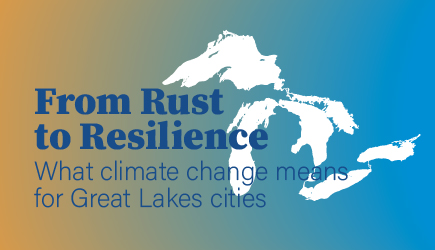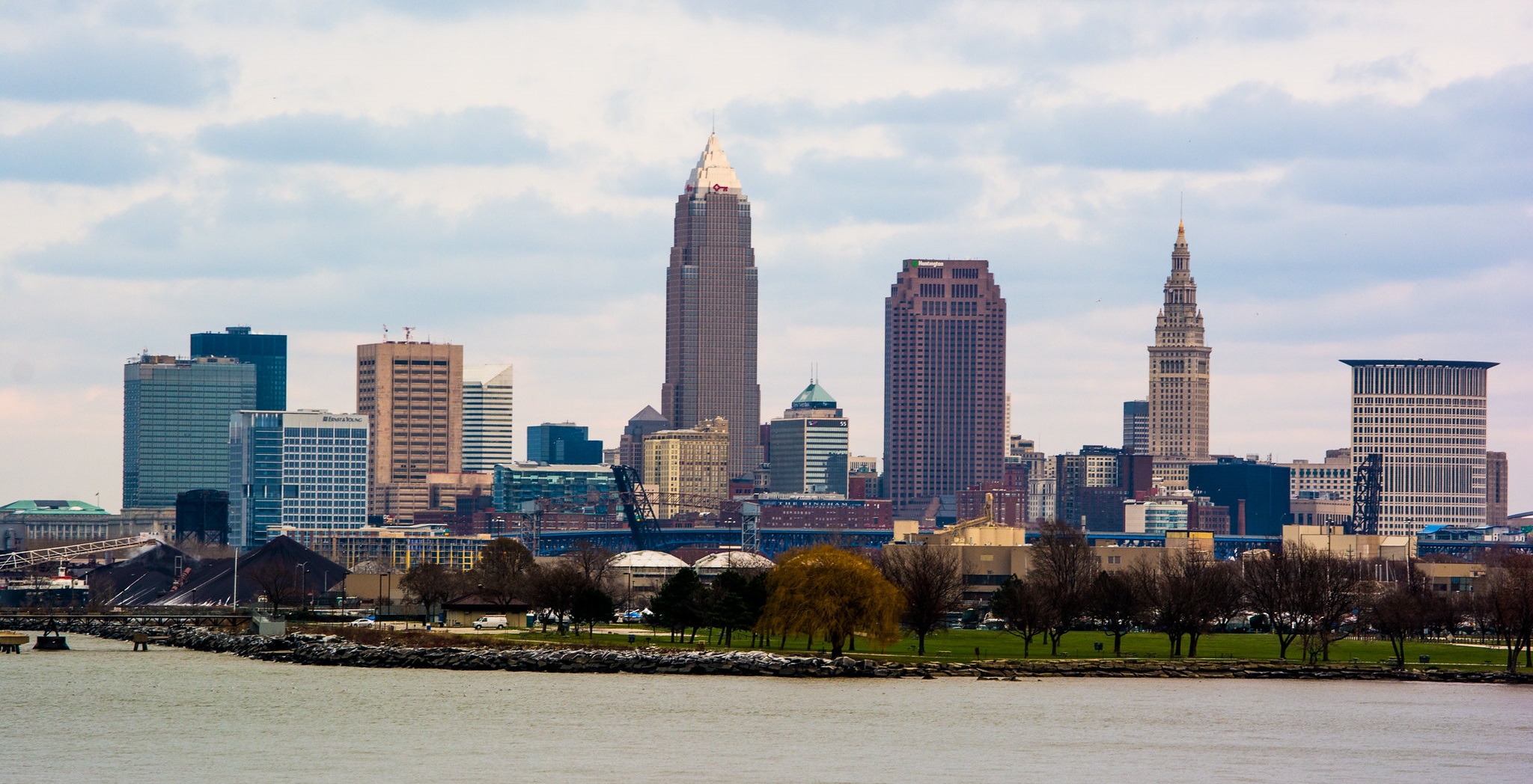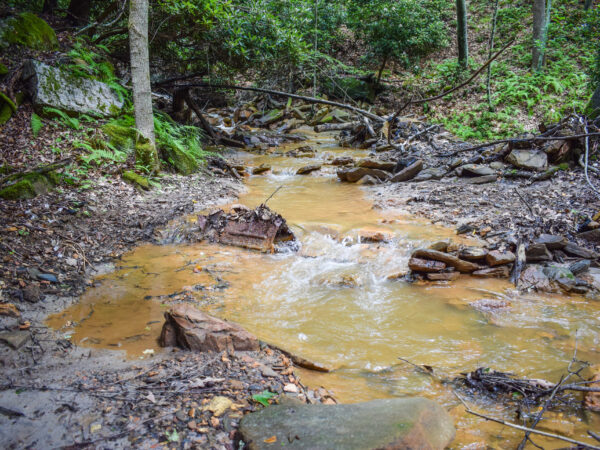
By Nina Ignaczak, Belt Magazine

This article is part of the Pulitzer Center’s nationwide Connected Coastlines reporting initiative. For more information, go to pulitzercenter.org/connected-coastlines-initiative.
For all stories in the “From Rust to Resilience” project, including the Great Lakes Now monthly show, click HERE.
Bird migration is underway on the southern shore of Lake Erie. At the Black Swamp Bird Observatory (BSBO), a road through a remnant of the once-vast Great Lakes coastal marsh is filling up with cars driven by birders, clutching binoculars and eager for an early glimpse of migratory birds. Robert Sink comes a few times a week from Findlay, Ohio, about an hour away, with his tripod and telephoto camera lens. He posts daily on a Facebook group for Ohio bird photographers. “When the season becomes warmer, I’ll be up here every other day or so,” he tells me.
Sink is part of the local tourism industry here, one driven largely by birders. Each May, the Black Swamp Bird Observatory’s annual Biggest Week in American Birding brings an estimated $40 million into the local economy. Among the top attractions this year: Two bald eagle nesting pairs. The eagles are a success story in Ohio; in 1979, just four nesting pairs remained in the state. By 2019, restoration efforts resulted in 346 documented pairs, most of them here, along this southern shore of western Lake Erie. The area is designated a “Global Important Bird Area” by the National Audubon Society.
Ninety miles to the east, off the coast of Cleveland, developers have proposed the Icebreaker Wind Project, a six-turbine array which would sit eight miles out in Lake Erie. The project, billed as a “demonstration wind farm,” would generate twenty-one megawatts; enough to power approximately seven thousand homes. Dave Karpinski, president of the Lake Erie Development Corporation, or LEEDCo, which is developing the project, said offshore wind energy has the potential to be a game-changer for Ohio and the Great Lakes.
Watch this Great Lakes Now‘s segment on the Great Black Swamp:
API key not valid. Please pass a valid API key.Renewable energy is not winning right now in this corner of the Midwest. In 2017, Ohio ranked forty-nine out of fifty states in renewable energy production, ahead of only Delaware; less than three percent of Ohio’s electricity came from renewables. As a whole, the Great Lakes states lag the nation in renewable energy production by twenty percent. LEEDCo projects Icebreaker could bring approximately five hundred jobs to Ohio with a $253 million local economic impact over twenty-five years. Beyond this project, LEEDCo predicts as much as five thousand megawatts of wind energy potential in Lake Erie alone. The total electrical energy capacity in Ohio was estimated to be just under twenty-nine thousand megawatts in 2019.
But some environmentalists aren’t happy, because the area is smack in the middle of a major migratory pathway for wildlife—and, they argue, while the project proposes only six turbines, its approval could unleash a tsunami of offshore wind development across the Great Lakes and put birds at risk. In December, two nonprofit organizations, the Black Swamp Bird Observatory and the Washington, D.C.-based American Bird Conservancy, filed a lawsuit against the Energy Department and the U.S. Army Corps of Engineers. It’s a last-ditch effort to halt construction of the turbines, and underscores one of the primary tensions at the heart of the case—how to ensure developers are doing enough to limit the negative externalities of a transition to sustainable energy production.

Biggest Week in American Birding at Magee Marsh Wildlife Area. Photo by James Proffitt.
#
The Icebreaker project was first proposed in 2009. Getting buy-in and permits has been a lengthy process, with opposition coming from environmental activists and the fossil fuel industry. But the end may yet be in sight. Last May, a settlement was reached between LEEDCo and the Ohio Power Siting Board for post-construction monitoring of the project’s impact on wildlife, including bird and bat mortality. As of now, seven of the eight permits required for the project to proceed have been secured, and its fate rests in the hands of the Ohio Power Siting Board.
At issue in the lawsuit is the science underpinning the National Environmental Policy Act (NEPA) process and the mitigation strategy. “In our view, this project still is lacking on a number of fronts with regard to the science, the analysis, and its likelihood of effectively protecting birds,” said Joel Merriman, Director of the Bird-Smart Wind Energy Program at American Bird Conservancy (ABC). “Given the level of risk and the precedent-setting nature of this project, even if it’s not a ton of turbines, we just feel it needs to be held to an extremely high bar.”
The suit calls for federal agencies to undertake a full Environmental Impact Assessment (EIA). Federal agencies are operating based on the conclusions of an Environmental Assessment (EA) under NEPA, which found that a full EIA was not warranted. “We think it’s absolutely inappropriate…that this would be held to an EA rather than an EIA,” added Merriman. “It seems very clear to us that the additional analysis that would come with the EIS would absolutely be necessary.”
One shortcoming, according to the plaintiffs, is a lack of adequate data and analysis. Merriman said that the EA gives preferential consideration to data generated by LEEDCo consultants as opposed to that collected by the Ohio Department of Natural Resources (ODNR). Mark Shieldcastle is research director for BSBO and a thirty-two-year veteran of the Ohio Division of Wildlife, where he worked as a wildlife biologist in avian research. He’s very suspicious of the data presented in the EA. “Every piece of data they have collected is highly suspect because of the methodologies used. And the data doesn’t really support the conclusions.” he told me.
For example, Shieldcastle said radar studies carried out by LEEDCo’s consultants were improperly designed. One, according to Shieldcastle, inappropriately used doppler radar while another restricted monitoring to clear nights, which are known to have less migration. “So the study design was designed to not see birds,” he said. “It’s not to say that it’s no risk or it is. We don’t feel the data’s there for it to go either way. The proper design has not been done.”
Another major gap, according to Merriman, is the lack of a cumulative impact assessment that considers future offshore wind projects. That’s because the EA process, while acknowledging that the intent of Icebreaker is to prove the case for future offshore wind development on the Great Lakes, did not consider future wind projects in its cumulative analysis, saying such goals to be “speculative.”
Shieldcastle said that’s ridiculous. “It may not be on paper yet but it is [planned],” said Shieldcastle. He pointed out that the project is underwritten by Oslo-based Fred Olsen Renewables, a subsidiary of offshore oil and gas company Fred Olsen Energy. The company reported $170 million in operating revenue in the fourth quarter of 2019. “They would not come to the United States for six turbines. They’re coming here for a much bigger piece of the pie.”
If the lawsuit fails and the Ohio Power Siting Board grants the permit, it will be required to comply with stipulations under the May 2019 settlement, including compliance with the MOU governing the pre-during-and-post construction mortality monitoring. It’s the first time the agency has made approval contingent on such a document. according to Shieldcastle. While Shieldcastle said he would have liked to have seen stricter requirements in the MOU, he’s is generally satisfied with the monitoring and reporting requirements under the agreement.
Karpinski said the conditions of the permit put LEEDCo on the hook. “There’s a very robust process and protocol in place that was the subject of negotiation, on what reporting would have to be included and what those thresholds were,” he said. “The OPSB has ultimate authority, and they can withdraw the permit for noncompliance.”
Many environmental organizations are supporting Icebreaker, including the Sierra Club, the Ohio Environmental Council, and the National Audubon Society. “We believe that throughout the siting process, LEEDCo and its partners have carefully studied and addressed the need to both develop a clean energy source to help combat air pollution and climate change with the need to protect water quality, fisheries and migratory bird paths over and around Lake Erie,” Miranda Leppla, OEC’s Vice President of Energy Policy, wrote in an email.
The National Audubon Society has also supported the project, pointing out in its filings to the Ohio Power Siting Board that the threat to birds from climate change is a significant threat. Garry George, the renewable energy director for Audubon, said he is satisfied with the conditions of the May 2019 stipulation and the monitoring MOU, particularly as they apply to monitoring of the Red-Breasted Merganser for which Lake Erie serves as a critical staging area. “The conditions we thought were exactly what we wanted,” George told me. “We were very pleased with the conditions that the staff report recommended, which we felt responded adequately to the issues that we raised in our comment letter.”
One of those conditions is that LEEDCo demonstrate an effective monitoring system to evaluate the impact of the turbines on birds. Such a system does not currently exist. “There’s no real technology for monitoring impacts of offshore wind on birds,” said George. “So we also asked for a validated monitoring system to be shown to work before the project could be constructed, or if it was constructed that determines it to be turned off during migration.”
So, should the OPSB approve its permit, LEEDCo will be responsible for building its own monitoring system even as it builds the turbines—and for demonstrating that the former works. In August 2019, the Department of Energy granted three-year funding to LEEDCo’s consultant, Western EcoSystems Technology Inc., to develop and test sensor technology to achieve regulatory compliance.
#
Across the marsh to the east, in the BSBO preserve, the Davis-Besse nuclear reactor rises in the distance. Just across Lake Erie in Michigan to the northwest, two more reactors, Fermi 1 and 2, are visible along the shoreline. Both facilities were built in the 1970s. Those reactors certainly cause bird mortality, Shieldcastle said. And both facilities must complete the full EIS under NEPA when their operating licenses come up for renewal or when they build new facilities.
But with climate change closing in, environmental groups find themselves navigating a complicated landscape, sometimes on opposite sides of the fence, or even in alignment with the fossil fuel industry. “You’ll see what the story is on the shores of Lake Erie,” George, from the Audubon Society, said. “You’ll see these birds come in and stage on the shoreline before they either fly over the Lake or go around the Lake. And so they just have huge numbers of these beautiful, beautiful warblers.”
It’s that spectacle that environmentalists are hoping to protect, even if they disagree about how best to do it.
###
Nina Misuraca Ignaczak is a freelance multimedia storyteller. She edits the Planet Detroit Newsletter and Metromode, writes for various news outlets and produces short documentary films. Find her work at ninaignaczak.com, and follow her on Twitter at @ninaignaczak.
“From Rust to Resilience: What climate change means for Great Lakes cities” is a collaborative reporting project that includes six members of the Institute for Nonprofit News (Belt Magazine, The Conversation, Ensia, Great Lakes Now at Detroit Public Television, MinnPost and Side Effects Public Media) as well as WUWM-FM Milwaukee, Indiana Public Broadcasting and The Water Main from American Public Media.
This project is part of the Pulitzer Center’s nationwide Connected Coastlines reporting initiative. For more information, go to pulitzercenter.org/connected-coastlines-initiative.

Read more from Great Lakes Now:



Featured image: Photo by Nina Misuraca Ignaczak.
2 Comments
-
I possess a vocation in Electronics Engineering (hobby as well) and I am very thankful for it, because if I didn’t, I would not have known what to suspect caused a sudden appearance of health issues to my wife, children, neighbours and myself.
For the 1st few weeks after my ears made an audible crunching sound in the middle of the night one night, I did not have any leads as to why my ears began to ring more each day until eventually becoming so 24×7. Then one early morning, I noticed I could not walk. Suddenly, I became severely dizzy. More issues appeared, such as wife and children, including a 9 year old, experiencing severe migraines. (9 YOs should not experience migraines.)
Then I noticed these issue varied in intensity proportionally to a very slightly audible “Whoom-Whoom” sound which was accompanied by a relatively high amount of vibration for such a quiet sound, which was present in our bedroom sometimes, almost always during the night. After seeing myself, while working from home, experience the room start spinning, 1.5H later, my daughter, all dressed to play soccer, unable as she is on the floor crying in pain, followed a few hours later by my wife experiencing a migraine which lasted 3 days, and all issues occurring after having been exposed to this pulsating sound and vibration, I began to try to determine the source of it.
For some time, I was not successful. One day, knowing the pulsating sound and vibration was particularly bad, while taking my usual morning walk, I looked to the west and observed a wind power array rotating at what I thought to myself must have been close to its rated RPM. As I was returning home, they all shut off. It stood out as I had never seen that before. I could not see the turbines from hay home, nor did I try to. But I observed when I returned home, that the pulsating sound and vibration was gone from inside my home. After a short time, it returned, so I looked and sure enough, the turbines were rotating again. I then timed the cycle of the closest turbine, and sure enough, a cycle in the “Whoom” sound and vibration matched a cycle in the turbine rotation. (When a blade passed the tower.)
From this time, I included the wind power array as a potential cause. That day I did what I could to eliminate any other potential causes, shut my main circuit off, walked the perimeter to determine if any machines were working. There were none.
Our health issues continued to vary proportional to the pulsating sound and vibration in our room. (And sometimes noticeable in other parts of our home) One day, we had access to a $45,000 class 1 certified infrasound measurement and processing system. This system could not only accurately capture infrasound emissions, but also other sounds present over a full range of frequencies. (Our government uses hand held meters which cannot do this, they capture only the dominant sound) The system clearly capture infrasonic emissions in our home at a fundamental frequency of 0.72 Hz and harmonics at multiples up to just under 20 Hz! This is consistent with what can be expected from wind turbines.
I also underwent a 2.5 year medical diagnostic, at the conclusion of which, my doctor concluded in writing “I do not know what else could be causing these issues.”
So I got my family the heck out of there. And guess what – all those health issues that were new to us went away. Even more – we moved next to a Great Lake and one of the busiest highways in North America – I can sense trucks using the highway while in bed if I try, but that is easy to disregard – and it is here that my family have healed. I further found 3 of my neighbours experienced similar issues, one mother and daughter up until they moved away. And they too recovered after moving away from the turbines, until another, larger wind power array started up near them and their issues returned.
I am not a wuss. I worked in factories and went 13 years without a single missed shift. But this, I could not ignore these health issues.
While I will keep an open mind, one could understand how I could feel learning that wind turbines could again be placed within 5 km of our home again.
My advice – government had better stop ignoring the risks (Their “protections” reject all infrasound and severely attenuate low frequency sound) and create a mandate of change.
Wind developers – you must improve upon work to nearly eliminate the blade pass frequency emission. Perhaps get the blade further from the tower, change blade composition, change tower design combination of all.
Wind turbine crews – if there is a retrofit of existing turbines to an improved design, you’ll get much more work. And it is pretty amazing work you do.
To create the mandate – fight like heck.
-
Check out the wind farms they put in Van Wert, Ohio and surrounding areas. There were lots of great promises, and none of them have panned out!




